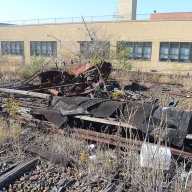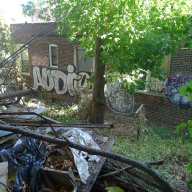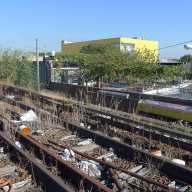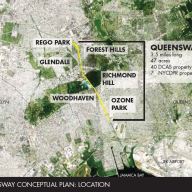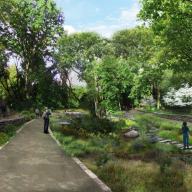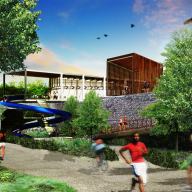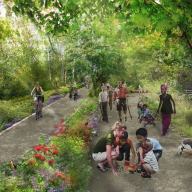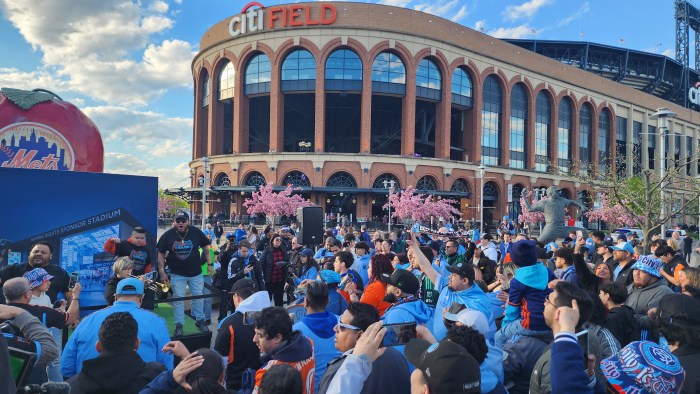As the debate rages on about what to do with the unused Rockaway Beach Branch Line of the Long Island Rail Road (LIRR), The Trust for Public Land is focusing its efforts on turning the 3.5-mile stretch of railway into a beautiful park ranging from Rego Park to Ozone Park, called the QueensWay.
Specifically, the organization is eyeing a half-mile section of the linear park straddling the Glendale/Forest Hills border to plant the park’s first foothold. That section is named the “Metropolitan Hub” and runs along the tracks from Metropolitan Avenue down to Union Turnpike.
For more than a half century, these LIRR tracks have lain abandoned as trees and undergrowth have begun to spring up, trash and litter has piled up, and drug and alcohol paraphernalia are strewn about. In 2011, the advocacy group Friends of the QueensWay was formed to see something better become of this land.
Recently, the Friends of the QueensWay joined forces with The Trust for Public Land, a not-for-profit organization dedicated to preserving open space and creating parks for people in and around cities.
“Our essential goal is to have every resident of a city in the U.S. have a park, playground, trail or greenway within a 10-minute walk from home, and we are working toward that goal,” said Adrian Benepe, senior vice president and director of city park development at The Trust for Public Land.
According to Benepe, New York City ranks seventh on the Parks Score — an assessment of the country’s 100 largest cities as to how well they provide parks to their residents — with 97 percent of New Yorkers living within a 10-minute walk to a park, playground, trail or greenway.
“New York does very well, but there are still pockets of the city where they have very little park access,” Benepe added. “One of those pockets is down in Ozone Park where there are very few parks and we’re working to address that. The QueensWay would provide a major antidote to the park desert, which is particularly bad in Ozone Park. Ozone Park, despite its name having ‘Park’ in it, has almost no parks.”
The QueensWay Vision
After holding five public meetings, 30 workshops and meetings with community groups, and even more discussions with community stakeholders, The Trust for Public Land has created a vision of what the QueensWay could be.
The QueensWay would be a new type of neighborhood park that would safely link to and enhance features of Queens’ third largest park, Forest Park. It would allow for a showcase of Queens’ diversity by hosting cultural events, and provide new opportunities for local businesses. The QueensWay would help connect children with nature by creating new play spaces, and create open space for neighborhoods that do not have enough park space, all while providing travelers with safe walking and biking routes to schools, stores and work.
Implementation
In order to implement the QueensWay, The Trust for Public Land has broken the 3.5-mile, 47-acre space into six distinct sections. The not-for-profit was funded to design a half mile of the route, and chose the “Metropolitan Hub” to be the first to get designed.
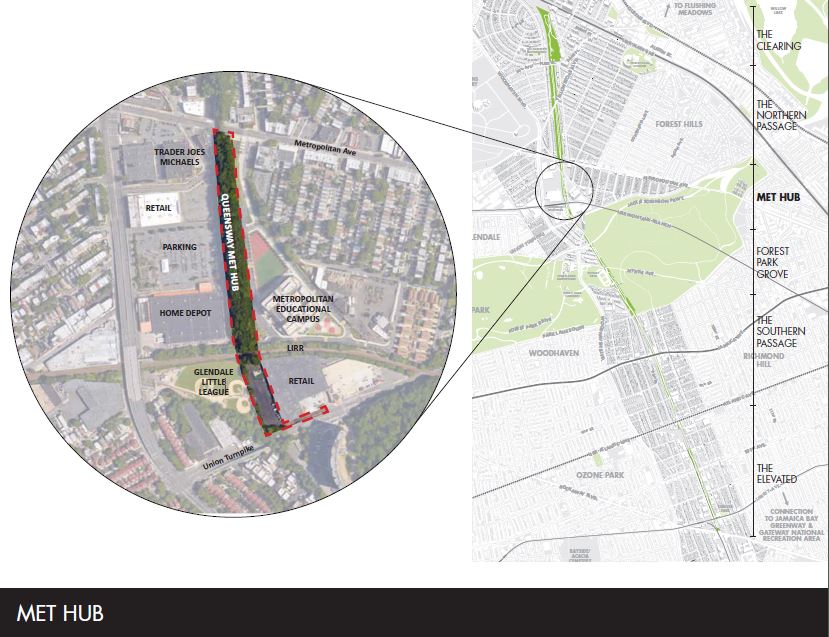
“The reason we chose that for two reasons: one is when you get to Union Turnpike there is a footpath and a bike path into Forest Park,” said said Andy Stone, director of the New York City Program at The Trust for Public Land. “The second thing is it runs by this Metropolitan Educational Campus with three schools on Metropolitan Avenue.”
This would provide travelers an alternate and safe way into Forest Park, and students at the local schools would get an outdoor educational space. The Glendale ballfields would also benefit from getting food concessions, batting cages and bleachers.
To implement this phase, it would cost between $12 and $15 million, Stone said. The total cost of the complete design and production of the QueensWay project would be approximately $140 million.
“Let me compare that to some other parks projects I worked on. So, $140 million all-in, is compared to, at the High Line (a 1.45-mile-long linear park built in Manhattan), $240 million so far, with probably another $30 million to go,” Benepe explained. “So the High Line may end up being $300 million for less than half the length and a seventh of the acreage.”
QueensWay as a connector
The QueensWay has the potential to connect hundreds of thousands of Queens residents — with 322,000 people living within a mile of the QueensWay — to many of the borough’s most visited attractions as several commercial corridors intersect with the QueensWays and seven subway lines within walking distance.
A park like the QueensWay would also connect Queens residents with the broad diversity of their own borough, by allowing for cultural events and festivals.
“There are times we use the term ‘cultural greenway’ because some of the neighborhoods that this runs though are — like so much of Queens — over half of the population are recent immigrants,” Stone said. “So there is a lot of interest, and it is wide enough in places to have spaces for festivals and other cultural events.”
QueensWay as an educational tool
The potential QueensWay would also provide the 12 adjacent schools within a five-minute walk with outdoor classroom space where students can learn about nature, ecology, wildlife, geology and more. Walking tours and nature walks could also be set up for other residents near the greenway.
Students would not be the only ones who would benefit from the QueensWay. Fitness buffs would also get to learn and improve their bodies with many of the proposed amenities.
“The completed QueensWay would provide 3.5 miles of off-road biking, walking and running paths, adult fitness zones, and playgrounds offering significant public health benefits,” Benepe said.
Political backing
Since the QueensWay plan was released in 2014, the plan has gained political backing from some of Queens’ biggest elected officials. Congressman Joseph Crowley, Congresswoman Grace Meng, state Senator Toby Ann Stavisky, Assemblyman Andrew Hevesi and Councilwoman Karen Koslowitz all came out in support of the plan when it was announced.
There are two big politicians who are currently on the fence about supporting this plan: Borough President Melinda Katz and Mayor Bill de Blasio.
Alternate use
Opponents of the QueensWay linear park believe it would be better to reactivate rail service to the Rockaway Beach Branch Line to bolster the severely lacking public transportation options in that part of Queens.
One such group is the Queens Public Transit Committee (QPTC), a grassroots organization focused on improving all modes of transportation throughout the city, are working to get service restored to the abandoned line.
Earlier this year, former Assemblyman Phil Goldfeder was able to secure millions in funding in the Assembly one-house budget proposal for a feasibility study to reactivate the line.
Although the need for more public transportation is great, supporters of the QueensWay argue, reactivating the Rockaway Beach Line comes with its own problems such as the time it would take to get done, the cost to the already cash-strapped MTA and purchasing the tracks from the city.
However, The Trust for Public Land is open to keeping the tracks in place in case the possibility to bring rail back one day becomes feasible.
“The reality is if the QueensWay project loses momentum, we really think the corridor is just going to sit there for many decades more,” Stone said.


